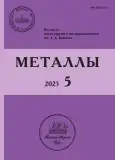RESESRCH OF THE KINETIC CHARACTERISTICS OF THE SOLID-STATE TRANSFORMATION OF Kh30N60M9 and Kh23N65M13 ALLOYS IN THE TEMPERATURE RANGE OF 500-650 °C, ACCORDING TO THERMOGRAVIMETRIC ANALYSIS
- Autores: Mikhaylov D.L1, Ermishkin V.A2, Minina N.A2, Kulagin S.P2
-
Afiliações:
- LLC "Promdetal"
- Baikov Institute of Metallurgy and Materials Science, Russian Academy of Sciences
- Edição: Nº 5 (2023)
- Páginas: 85-92
- Seção: Articles
- URL: https://journals.rcsi.science/0869-5733/article/view/247403
- DOI: https://doi.org/10.31857/S0869573323050105
- EDN: https://elibrary.ru/IYKCCU
- ID: 247403
Citar
Texto integral
Resumo
The results of the study of the structural states of single-phase alloys Kh30N60M9 and Kh23N65M13 for the conditions of heating samples at a rate of 1.0 °C/min are presented. The structural states of the alloy samples were obtained by water quenching; the alloy quenching temperature was 1107 and 1135 °C, respectively. The article presents the results of thermal analysis of samples of the considered alloys in the conditions of an inert gas - argon, without carrying out its additional purification from oxygen, the volume fraction of which was up to 0.003 %. As a characteristic of the structure state, an indicator of the rate of weight gain is proposed. According to the experimental results of weight gain, an original method for calculating this kinetic indicator as the rate of solid-state transformation, then the conversion coefficient (k) is proposed. The true values of weight gain considered are referred to the true values of temperatures in the temperature range of 500-650 °C, when the scales of variables and values of variables are proposed in the range of true values (0..1). As a result of the work, confirmation of the improved thermophysical characteristics for the Kh30N60M9 alloy in the considered temperature range was found, in comparison with the Kh23N65M13 alloy. The calculated indicators of the conversion coefficients of the alloy samples were confirmed by experimental data on the amount of enthalpy in the considered gradations of the temperature range, for which the areas under the DTA graphs of the Kh30N60M9 and Kh23N65M13 alloy samples were calculated for the conditions of heating the samples at a rate of 1.0 °C/min. It was found in the work that the decomposition of the solid solution structure is more inherent and essential for the structure of the Kh23N65M13 alloy in the temperature range of 500–650 °C.
Palavras-chave
Sobre autores
D. Mikhaylov
LLC "Promdetal"
Email: ooopromkey@gmail.com
Veliky Novgorod, Russia
V. Ermishkin
Baikov Institute of Metallurgy and Materials Science, Russian Academy of Sciences
Email: vermishkin@imet.ac.ru
Moscow, Russia
N. Minina
Baikov Institute of Metallurgy and Materials Science, Russian Academy of Sciences
Email: ooopromkey@gmail.com
Moscow, Russia
S. Kulagin
Baikov Institute of Metallurgy and Materials Science, Russian Academy of Sciences
Autor responsável pela correspondência
Email: ooopromkey@gmail.com
Moscow, Russia
Bibliografia
- Пат. РФ RU2613805. МПК С22С 19/05 (2006.01), C22C 30/00 (2006.1). Коррозионно-стойкий сплав на основе никеля. Михайлов Д.Л. - №2016105314; заявл. 2016.02.17; опубл. 21.03.2017.
- Харин, П.А. Эксплуатационные и технологические свойства сплава ХН62М / П.А. Харин, Н.Г. Зинченко [и др.] // Проблемы черной металлургии и материаловедения. 2019. №34. С.48-58.
- Pai, H.C. Influence of Mo addition on the solvus temperature of Ni2(Cr,Mo) phase in Ni2(Cr,Mo) alloys / H.C. Pai, M. Sundararaman, B.C. Maji, A. Biswas, M. Krishnan //j. Alloys and Compounds. 2010. V.491. P.159-164.
- Гамбург, А.С. Исследование нового никелевого сплава ХН62М на стойкость к межкристаллитной коррозии / А.С. Гамбург, А.О. Гусев, А.Ф. Гибадуллина [и др.] // Уральская школа молодых металловедов: сб. матер. и докл. XIX Междунар. науч.-техн. Уральской школы-семинара металловедов - молодых ученых (Екатеринбург, 19-21 ноября 2018). - Екатеринбург: Изд-во Уральского ун-та, 2018. С.389-392.
- Sabir, F. Study of heat treatment effects on mechanical and structural properties of steel G-35 based on nikel / F. Sabir, O. Ben Lenda, S. Saissi, K. Marbouh, L. Zerrouk, A. Ibenlfassi, A. Jourani, R. Boulif, E. Saad //j. Sci. Arts Year. 2015. №3(32). P.269-284.
- Петрунин, Г.И. Теплофизические свойства вещества Земли. Ч.1 / Г.И. Петрунин, В.Г. Попов. - М.: Физический факультет МГУ, 2011. 68 с.
- Бахриденова, Д.Б. Определение кажущейся энергии активации по кривым ДТА / Д.Б. Бахриденова, А.Б. Алькенова, К.Ж. Жумашев, А.К. Торговец. -Темиртау: Карагандинский гос. индустр. ун-т (Респ. Казахстан), 2012.
- Обзор от компании HAYNES (USA) - производителя никелевых сплавов. https://www.haynesintl.com/alloys/corrosion-guide/metallurgy
- Xishan Xie. The precipitation and strengthening behavior of Ni2(Mo,Cr) in HASTELLOY® C-22HS® alloy, a newly developed high molybdenum Ni-base superalloy / Xishan Xie, Yanping Zeng, Lizhong Kou, Jianxin Dong, L.M. Pike, Dwaine Klarstrom // Superalloys 2008: proceedings of the XI Intern. Symp. on Superalloys. doi: 10.7449/2008/Superalloys_2008_799_805.
- Jianxin Dong. Structure control of a new-type high-Cr superalloy / Jianxin Dong, Zhongnan Bi, Ning Wang, Xishan Xie, Zhigang Wang // Superalloys. 2008. V.41. P.50. doi: 10.7449/2008.
- Суровой, Э.П. Термопревращения в наноразмерных слоях MoO3 / Э.П. Суровой, Н.В. Борисова // ЖФХ. 2008. Т.82. С.2120-2125.
- Жиляков, А.Ю. Низкотемпературное старение никель-хром-молибденового сплава G35 / А.Ю. Жиляков, А.А. Попов, С.В. Беликов // Современные проблемы науки и образования. 2014. №4. С.236.
Arquivos suplementares









